Hasegawa 1/48 “Year of the Cat” F6F-5 Hellcat, the first U.S. Navy Blue Angels plane
Tonight's presentation is hot of the work bench. It is the second completed build for this year, (but most of the work was done last year...).
I have been building a set of four Hasegawa F6F Hellcats as part of our current "Year of the Cat" Group Build. Here is a link to the build log on the planes if you are interested in checking it out.
This is the second Hellcat of the four F6F's that have now been completed...
A few nights ago I posted an article about the NAS Daytona Beach Hellcat. Here's a link for it too just in case...
The Blue Angels were started back in April 24th,1946, shortly after the end of World War Two. Admiral Nimitz ordered the Chief of Naval Training at NAS Jacksonville to put together a flight demonstration team.
Lieutenant Commander Roy M. "Butch" Vorhis was the Chief Flight Instructor of the Instructor Advanced Training Unit stationed at Jacksonville NAS. He was picked to organize and develop the new team.
Here is a picture of the very first Blue Angels team. This original photo is in the Ginter book on F6F Hellcats and is credited to the USN.
The captioning below the photo in the book reads as follows:
"the first team, left-to-right: LT Al Taddeo, LTJG Gale Stouse, LCDR "Butch" Vorhis, LT Maurice Wickendoll, and LT Mel Cassidy. (USN)"
Here I tried to capture the look of the Hellcat in the background of the Group photo. If you look closely at the original picture, the spinner hub is dark, possibly painted in dark blue or black in the original picture. I chose to leave mine in a natural metal color as seen in the in flight formation photo. This picture could support the story that two sets of planes were used...
The Grumman F6F-5 Hellcat was chosen as the plane the demonstration team would use. Unfortunately, the plane was not used for very long as the newer Grumman F8F-1 Bearcat would soon replace it after only a few months. The Bearcat would be operated by the "Blue's" starting in August of the same year.
Another little interesting bit of information is that during this time, the Blue Angels were simply known as the "Flight Exhibition Team". They were not called the "Blue Angels" until 1947, when they were officially renamed to what we know them as today.
Since the Hellcats were only used for a few months, not too many original era photographs are known to exist today. However I did manage to find a few. This picture shows three of the planes in formation. This is claimed to be the very first "Official" picture of the Team.
There were supposedly two sets of planes used by the team.
Some sources state the planes were painted in a slight variation with different style of lettering used on each set. Since there is so little documentation, this model is built as a "best guess" estimation as to how they could have looked.
Here is another photo I found that shows one of the Team taxiing out for the very first air show, which was given at Craig Municipal Airport in Jacksonville, Florida, on June 15th, 1946.
and a picture I took of my model, using the black and white filter to see how close I came to the original picture.
along with the same picture in color before going to the black and white shades.
There is some controversy surrounding the style and color of markings. Some sources state the planes didn't have the US NAVY letters under the wing on the Hellcats. I managed to find a picture that was enhanced by the author showing how the letters may have been.
I was fortunate enough to have our fellow Imodlers help with information on this build. Allan J Withers was kind enough to post pictures for me of his Blue Angels Hellcat.
Jim Sullivan was kind enough to share some pictures with me and his personal thoughts on the colors of the letters used on these planes.
Thanks Guys ! Without your help this one would not have been as accurate... 🙂
This is a great website and we are very fortunate to have some fantastic persons here...
The current consensus on the colors used is that US Insignia Blue FS 15044 was "probably" used on the original Hellcats. Currently Model Master only offers this color in a "Flat" sheen. It's not glossy at all, so a lot of clear will be required to make it shine if you use this color... If memory serves me, I had three coats of Future and some wet sanding with 2000 grit wet or dry paper in between coats.
Years later when Butch Vorhis was interviewed, he stated that they had the planes repainted in a lighter shade of blue. He added that it was a color that was no longer used by the US Navy. Since the US Navy went over to an overall Glossy Sea Blue finish on it's planes, the "Insignia Blue" was no longer needed as a back ground color on the US Star Insignias. It is possible that "True Blue" may have been used, but I think that it's way too light ...
In his interview, Butch Vorhis was asked why they didn't take more pictures of the planes. He replied something like this... "At that time, we were busy trying to get the team together and the flight demonstration figured out. We never knew it would become something as big as it is." So this would explain the lack of photos...
Currently the "Blues" use FS 15050 which is appropriately called "Blue Angels Blue".
Similar controversy exists on the colors of the letters and numbers used on the original Hellcats as part of the "Flight Demonstration Team".
Some sources indicate that actual Gold Leaf was used, while others stated a color very similar to "Insignia Yellow" was used. To be perfectly honest, I don't think anyone knows for sure...
So I went with Jim Sullivan's recommendations and went somewhere in the middle with this. I used the decals produced by a company called "Bestfong". They were OK and came with a separate white set of decals to use as an underlayment for the yellow.
I opted not to use the white and simply placed the yellow decals directly over the blue back ground.
The Blue Angels Hellcats had several modifications done to them. From what I have read, the armor plating, all weapons, and the gun sight were removed. They had the leading edge openings for the .050 caliber machine guns faired over. My best guess is that the empty shell casing ejector chutes under the wings were covered as well.
This Hasegawa kit was a very nice build. I ran into a few self induced hiccups though. I fogged the canopy for one... I'll call that operator error / head space and timing problem.
Two more Hellcats to go... and they should be done soon.
A great big "Thank You" goes out to Jim Sullivan and Allan Withers... and to those who have made comments encouraging me along the way during these multiple builds.
As usual, comments are encouraged.

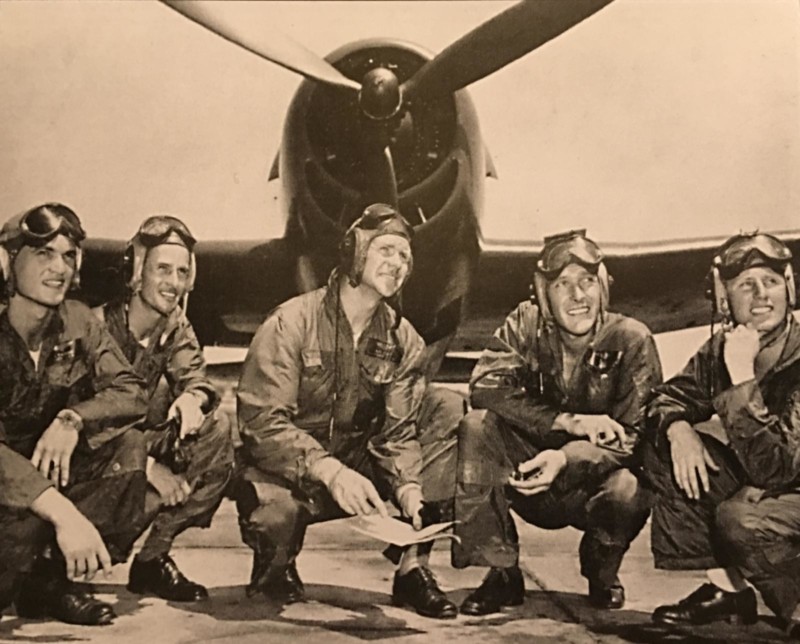
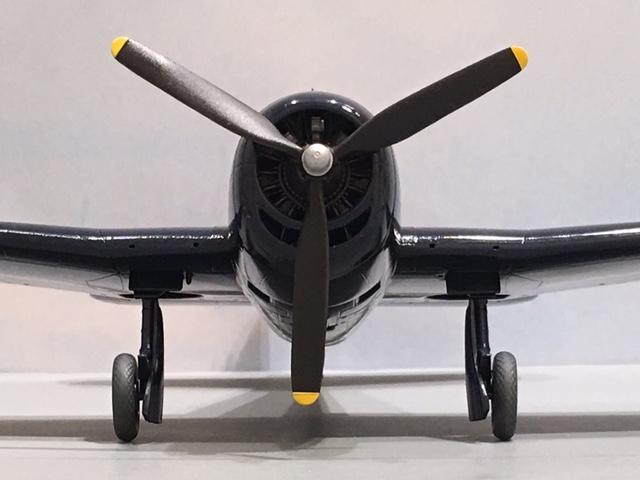
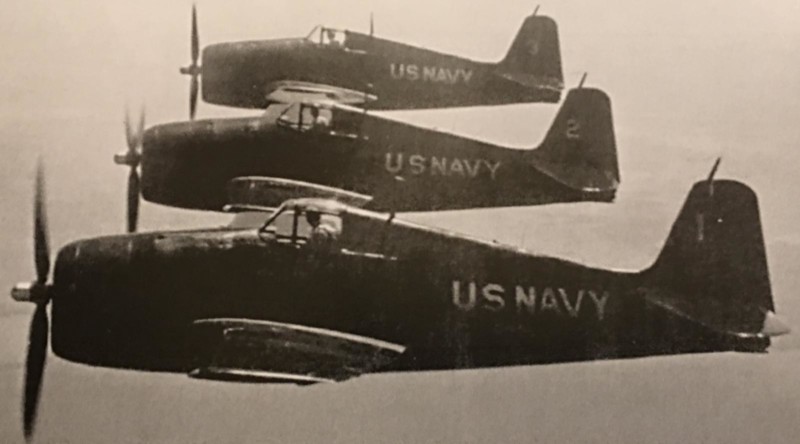
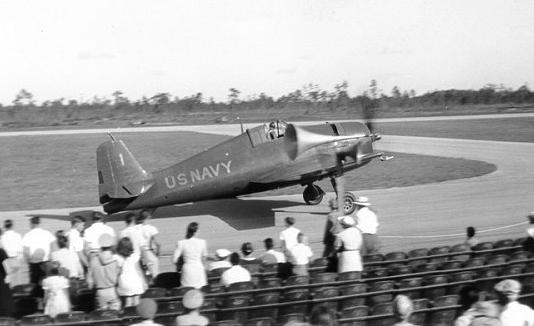
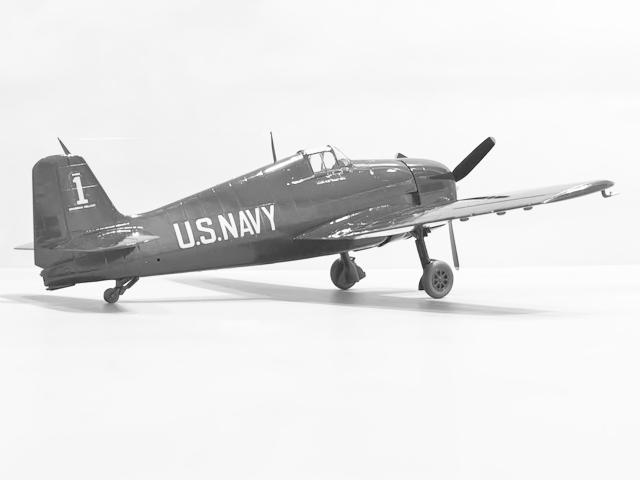

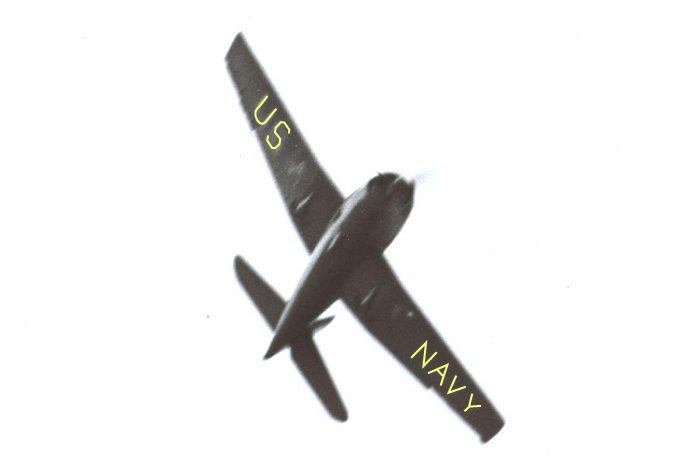
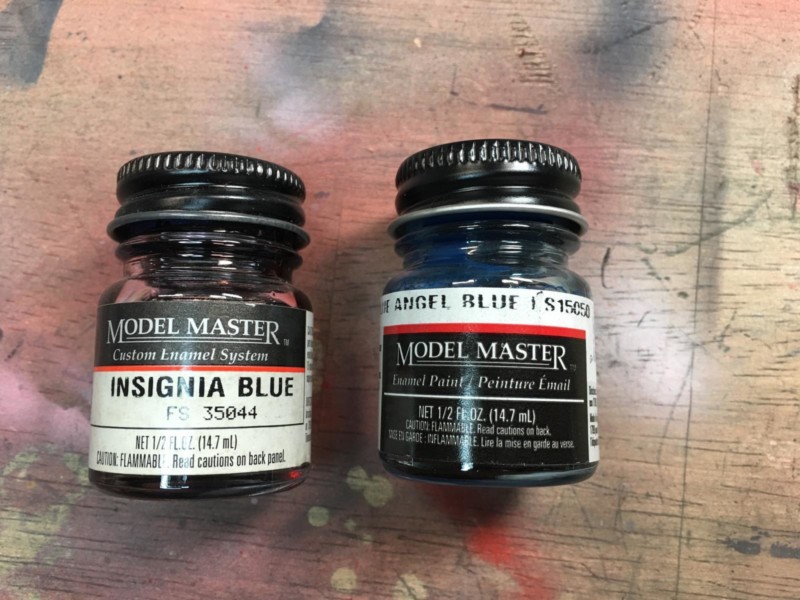

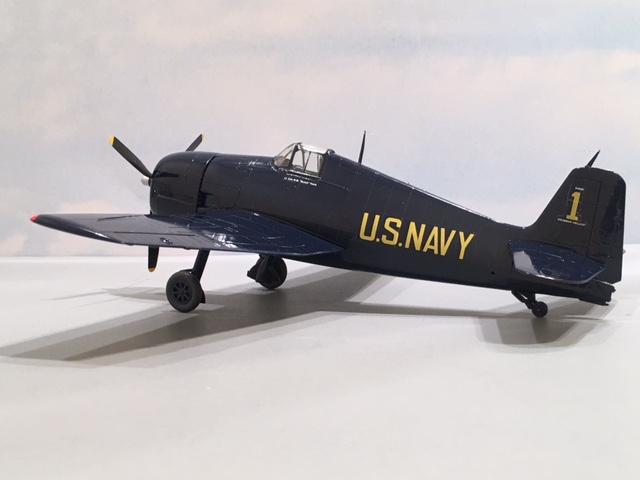
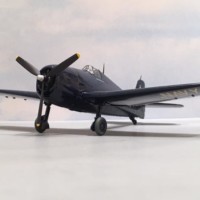
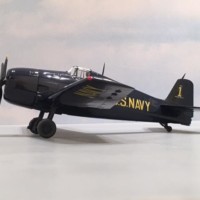
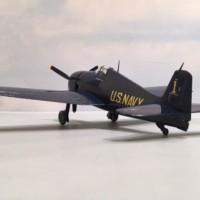
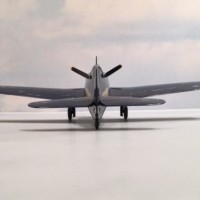
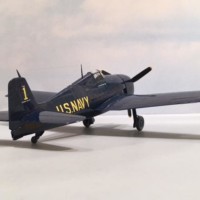
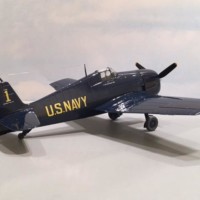

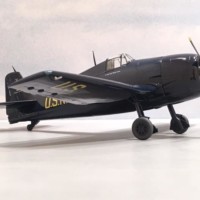
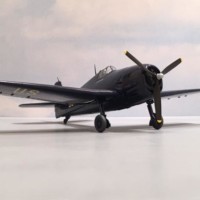

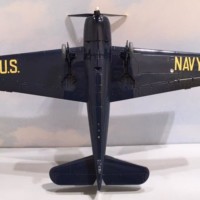
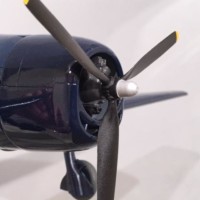
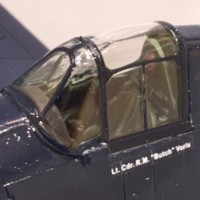
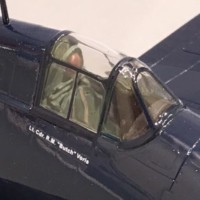
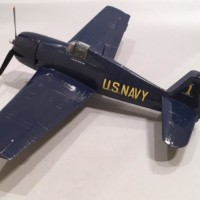
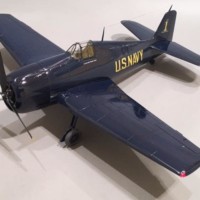
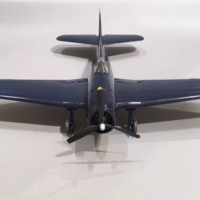
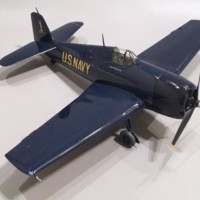
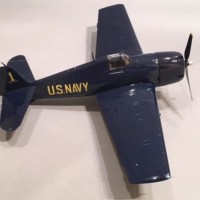
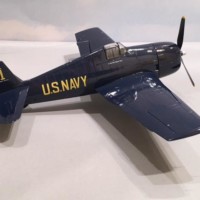
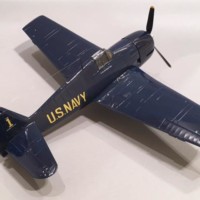
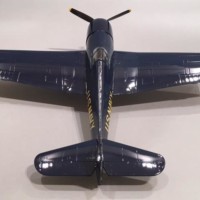
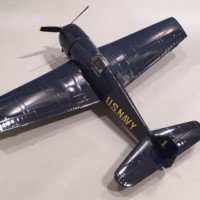

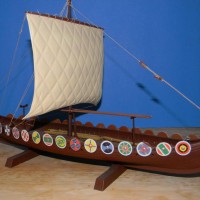
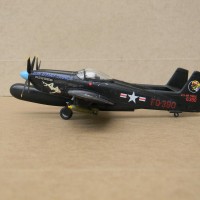

Very nice Louis. Yellow state nice and sharp
Thanks George.
I like it, Louis...a nice presentation. I've had several "back-and-forth's" with Jim as well...he's always been very helpful - especially when it comes to projects such as yours. Looking forward to the next 'Cat. 🙂
Yes Craig, Jim has been very helpful that's for sure. I hope to have the next Cat done pretty soon. Only two more left ...so you shouldn't have to wait too long. Thanks for the compliments and for "liking" the article.
The Iron Works' production line must be starting to look a little empty as yet another finished model makes its appearance here. This one looks great as well, I like the monochrome photos very much, and, of course, your research helps bring everything to life. Full marks and a distinction.
The assembly line is getting a little bare with two of the four Hellcats tucked away in the display case now... I still have a few kits to finish for the Kasserine Pass GB and the line will pick back up again with the assembly of four Tamiya 1/48 FW-190's (one of which will also be for the Kasserine Pass GB).
I am extremely pleased with how this one turned out. I didn't realize just "how close" I got this one, until I posted the B & W photo as a comparison of the original plane to the model... The style of lettering is off a little, but I can live with this...
I have had just as much fun with the research as I did building this subject. Thanks for the kind words George and for "liking" the article too.
Take care my friend.
This is exceptional, Louis. What I am enjoying the most is that the final product really looks so much like the original and that this is borne out by the photography. The head on shot after the original with the first flying team, and then the black and white version below the shot at Jacksonville are perfect! I've followed this with interest as a 'work in progress' and I didn't 'get' the gloss finish until I saw these photos with your model - especially the shot that you have provided in b+w and also in colour. You have made a basically one-coloured and pristine condition aircraft come to life - difficult and brilliant!
Thank you Paul for the compliments and following the "work in progress" builds.
On a whim I decided to post the two pictures you mentioned. So I "posed" the model as close to the original positions in the photos as I could. Once I saw the side view as a comparison to the B&W airshow taxi photo, I knew I got it as close as I could have ever done. It was the moment of truth as they say...
I wanted this plane to be very glossy and shiny since I thought as a "Show" plane the originals would have been too. They also would have been very well maintained, just as the planes used by the Blue Angels are today.
With this in mind I did not chip anything, weather it or even add exhaust stains... These particular 'Cats probably looked better than show room new.
The ticket to getting the maximum shine, was wet sanding the airframe in between the Insignia Blue and the clear Future coats. I sanded again after several coats of Future were applied. The last layer of Future was sprayed on straight, not thinned, and was sprayed on so heavy that I thought it might run.
Luckily for me it didn't...
Thanks for the compliments my friend.
Great 'Cat, Louis ! You can't go wrong with ANY Hellcat, especially one of the rarest ... a Blue Angels ShowCat. (Or should I say "Flight Demonstration Team ?!) Your model captures the spirit of the team. I think you're right concerning the particular color as well as the yellow lettering. In both photographs of the early planes' lettering looks too subdued to be white, in my less-than-expert opinion. Yellow just seems right. I'm not a big fan (in general) of glossy military combat planes from the WWII era, but these planes were for show, so I'll agree and I'd go with the gloss finish because I bet they did, too.
Getting help from Allan and Jim was a good idea. I'd love to know what little they have forgotten ! I certainly don't have the facts, pictures, or knowledge those fellows do, or from MANY other folks here on iModeler ... it's a great sight and extremely interesting. Thanks for sharing all the photos and the background story, too.
Take care, Amigo!
Jeff
Hello my fellow DAT brother !
Good to hear from you. You got it right with the "Flight Demonstration Team"... 🙂 🙂 🙂
I tried the yellow "US NAVY" decals in several different ways. First I used the provided white underlayment letters that were a separate decal... This made the yellow more of an orange yellow like the Team uses today. I used one of the rudder numbers that I was not going to use on the model as a test for this.
Then I actually made two number #1's for the rudder out of gold colored "Bare Metal Foil"... They looked OK but you could definitely tell they were home made. So off they came... If I had a proper set of gold leaf type decals, I probably would have used them. After all the Navy has wings of "Blue and Gold"... just my thoughts.
Finally I settled on just the yellow for the decal and applied it directly over the Insignia Blue without using the white base decal. This seemed to be just about right and fit "somewhere in the middle" as Jim Sullivan put it... so I went that route.
It was the help I obtained from our friends here, that made this model as accurate as could be considering the information that is available at this time. So I mentioned them in the article which is the proper thing to do.
I often try to include a little history lesson with my build posts... I'm glad you enjoyed this and that you "Liked" the article too...
Talk with you soon brother...
Thanks again...
According to Barrett Tillman, who knew Vorhis well, it was "a color lighter than Navy Blue and darker than the current Blue Angels color."
I think you're probably as close as anyone can figure out. A well-informed "edumacated guesstimate" is as good as we're going to get here.
Nice work.
Thanks Tom.
It’s probably never going to be 100 percent confirmed as to what exact colors were used on these Hellcats used by the Team, just as you stated.
Like you, I think I got it “close enough” for government work………………
The B&W photo I posted of the model as a comparison really shocked me. It was that “Aha” moment once I saw it posted online………….
Thanks for the compliments and for “liking” the article too.
Thanks Tom.
It's probably never going to be 100 percent confirmed as to what exact colors were used on these Hellcats used by the Team, just as you stated.
Like you, I think I got it "close enough" for government work...
The B&W photo I posted of the model as a comparison really shocked me. It was that "Aha" moment once I saw it posted online...
Thanks for the compliments and for "liking" the article too.
Ooops... I hit the enter key too quick. Sorry
Another nice one from the Gardner factory! I especially enjoy the motivation behind the build - trying to match an historical aircraft. Nicely done!
Thanks for the kind words Greg... I tried to pick planes that were colorful as well as historically significant.
My goal is to eventually build Hellcats in every color scheme. I have a few FAA planes coming up in the near future. But I will wait until we get the 100 Years of the RAF Group Build started first.
I plan on getting the Drone plane done soon. Possibly later tonight or tomorrow... so please stay tuned my friend.
Thanks again.
One beautiful Angel, Louis!
Thanks Robert. As a former Navy man I thought you might enjoy this ...
I'm really enjoying this build series of yours, Louis! Great work and great subject matter that you don't often seen modeled.
Thanks for the kind words Drew. The plan is to eventually build a Hellcat in every major color scheme.
I still need to build a very early dash 3 version in the Blue Gray over Gray. I'm also going to build a camouflage and a Gloss Sea Blue FAA plane, but these will happen later in the 100 Years of the RAF Group Build.
The remaining kits in the stash will be built as various Stateside Training planes (and possibly a Post War Reserve F6F) and some more colorful drones.
Thanks again Drew. Please stay tuned to the Iron Works for future updates... many more to come, God willing.
An excellent presentation of the origin of the US Navy flight demonstration team Louis. I appreciate the history and start up of what is today the Blue Angels. You did well and thank you for an excellent build.
Thank you Chuck !
As a US Navy man I was hoping that you would enjoy these Hellcat builds. I wanted to write something about the history behind how the original Team started.
Your recent F-51 Mustang article was very interesting...I really enjoyed it too. It struck home since my Dad was a Korean War veteran.
Thanks again my friend for the compliments and for "liking" the article too... Take care buddy.
Well done Louis, the Iron Works seems to be producing some great looking product.
Thanks Tom... You have built some pretty amazing P-40's, and P-39's lately, plus now you have a cool P-38 going too... I appreciate the compliments.
Outstanding Louis, we rarely see a Hellcat in those markings.You did her proud and I extend my compliments for a fine build.
Thanks Jim for the compliments. I really don't think this one would have turned out as nicely as it did without the information that was provided by you and Allan. Thanks again for everything you did. I'll be building up a few more of these State side training 'Cats in the near future. Take care my friend.
But I have two Tamiya F4U-1 builds that have been idle for too long now. I need to get those completed first.